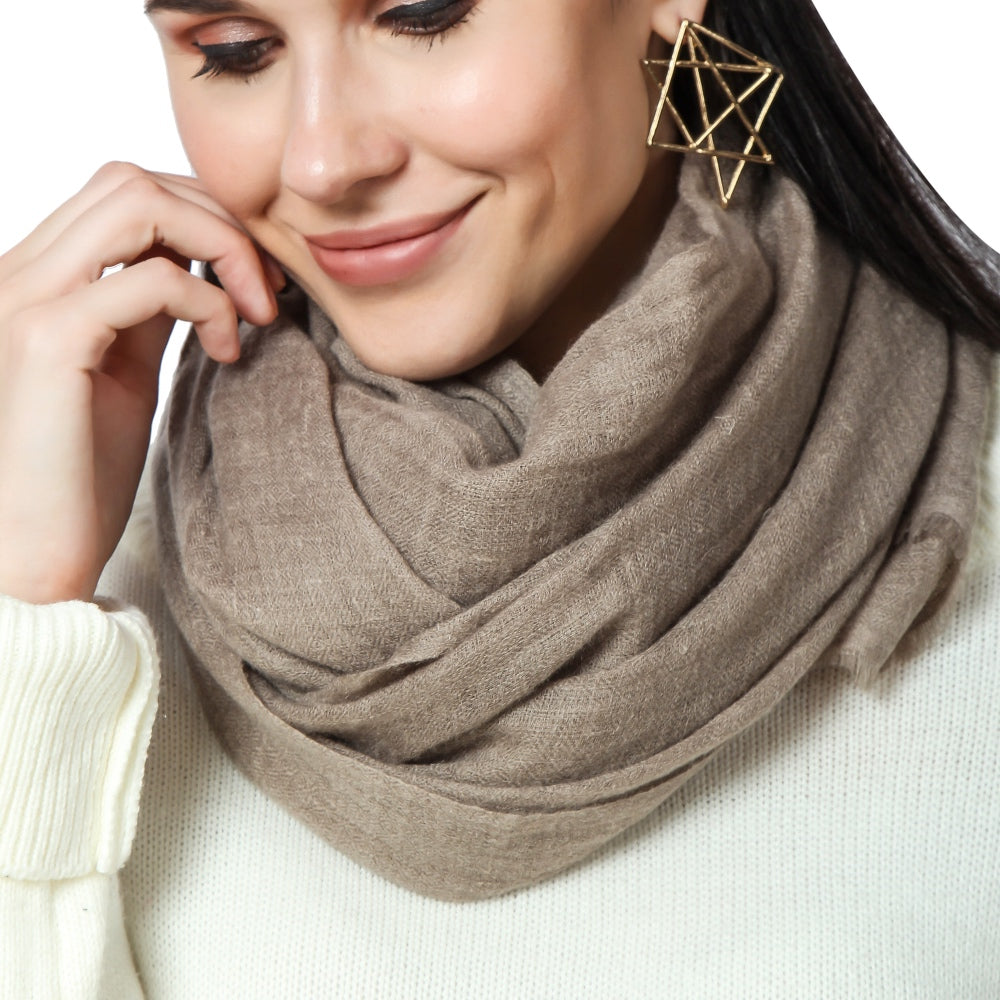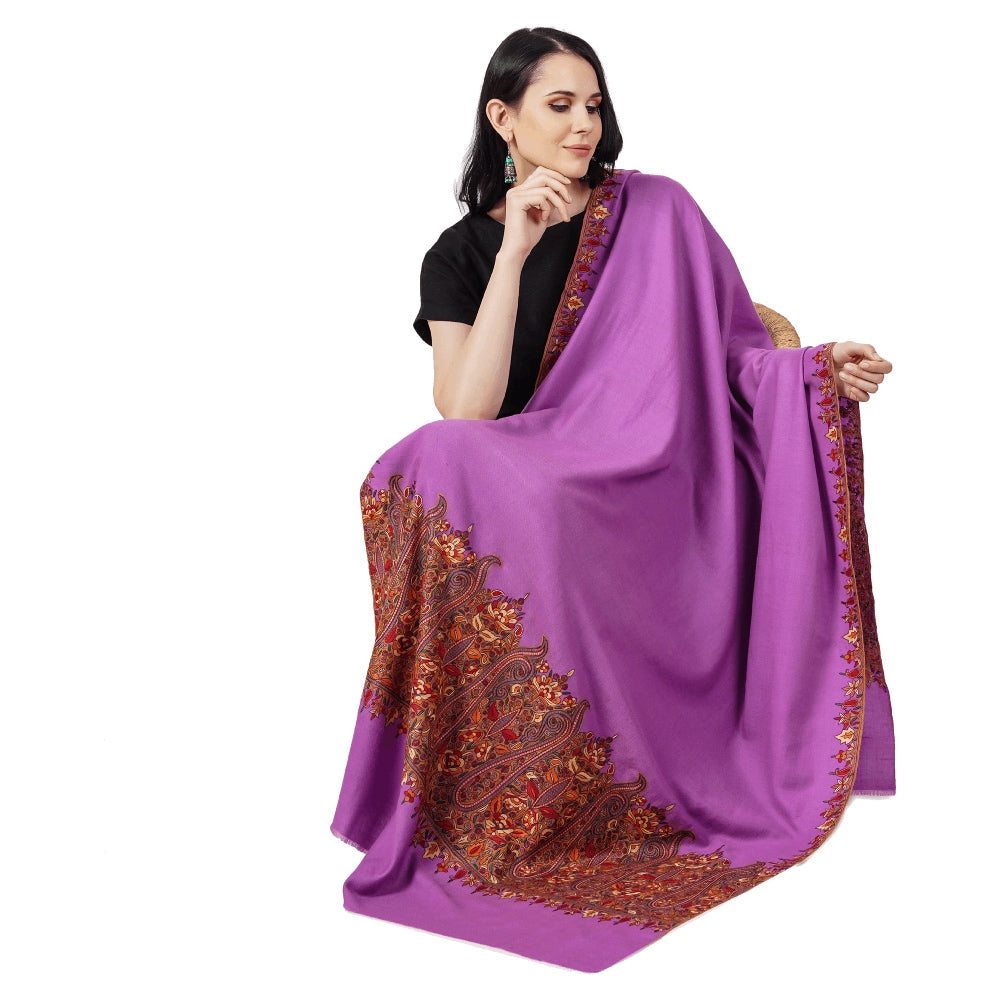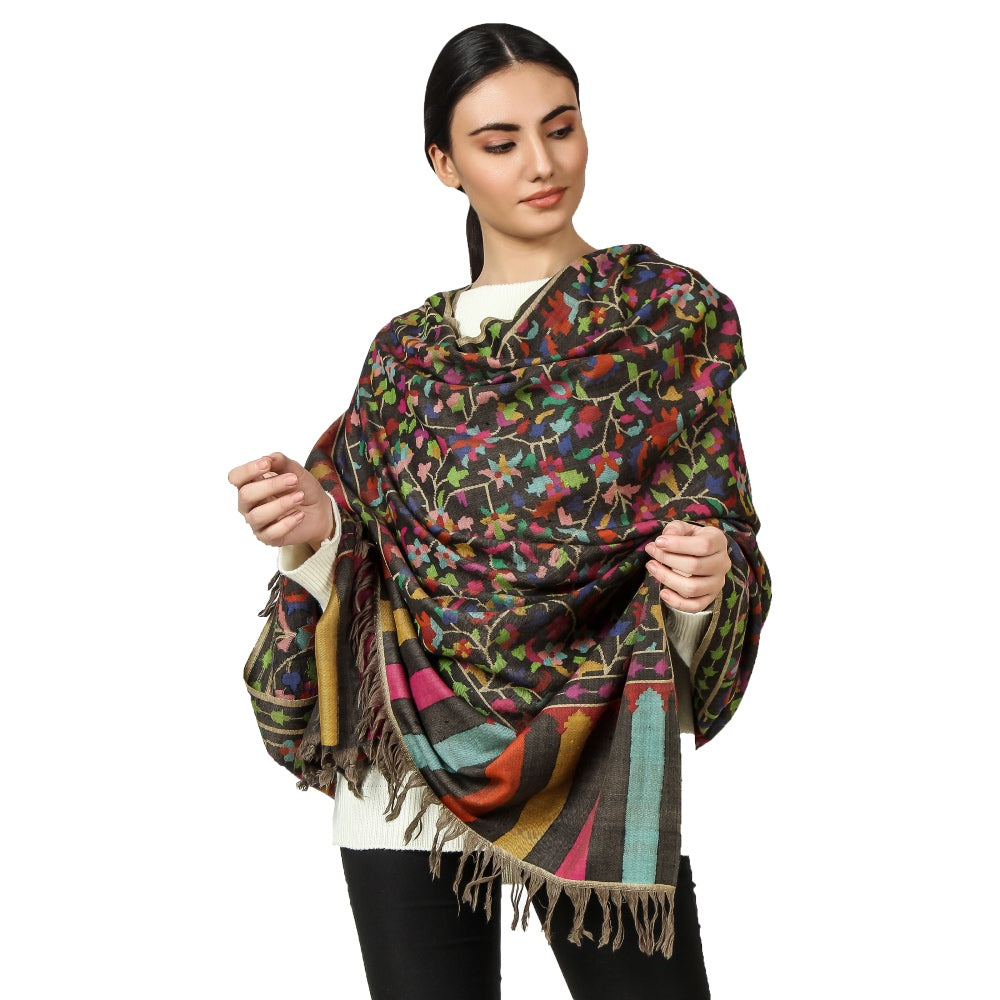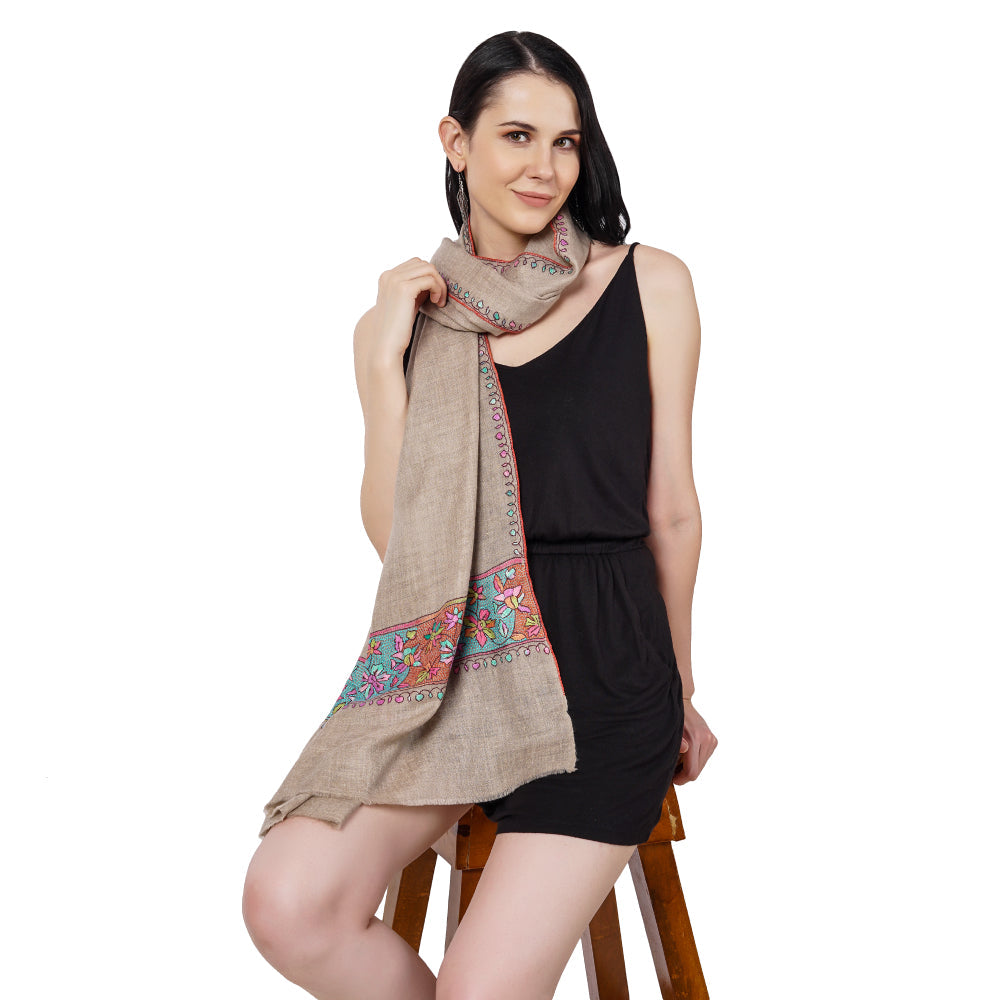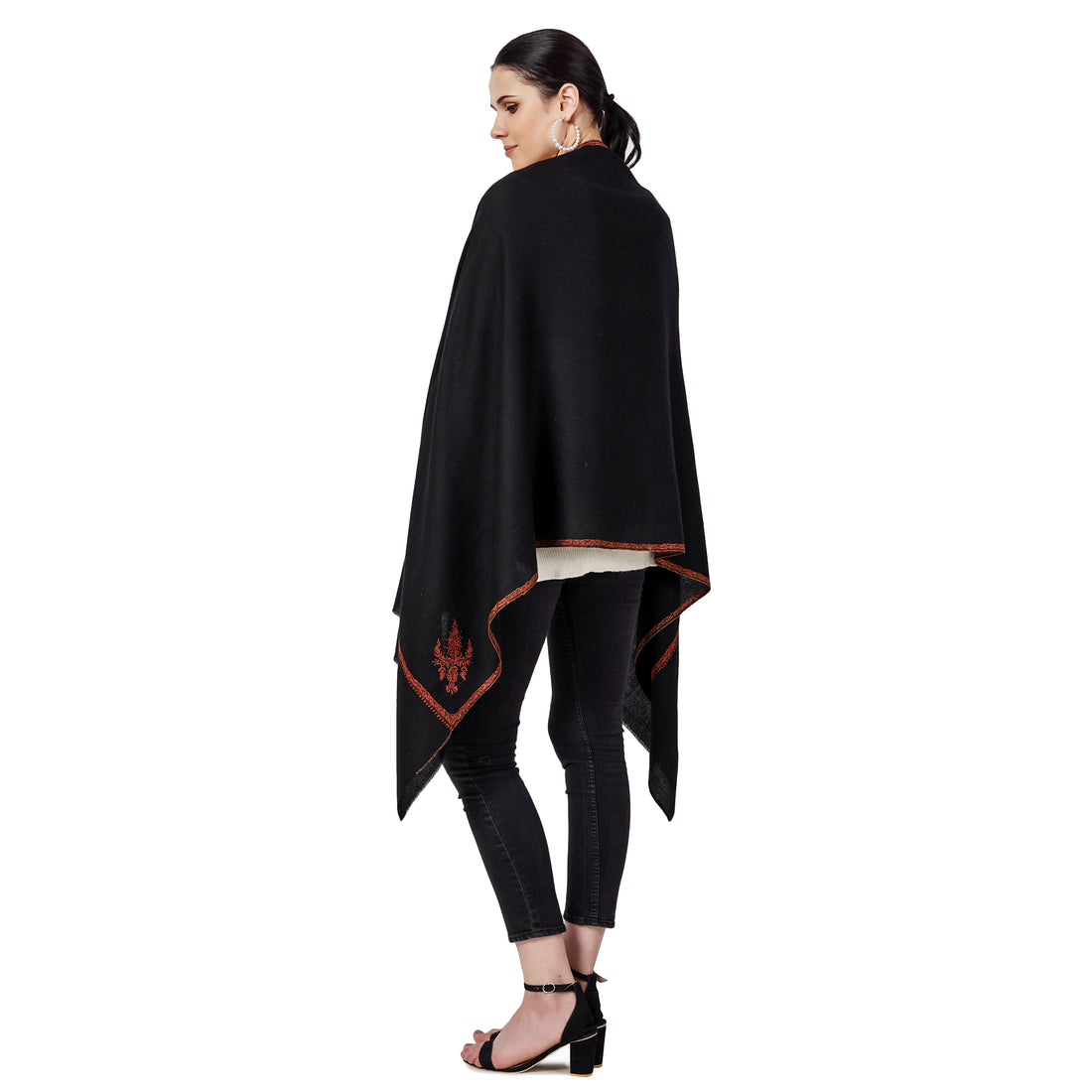
What is Kashmiri Pashmina? A Complete Guide to the Luxurious Fabric
Share
Explanation of what Kashmiri Pashmina is:
Kashmiri Pashmina, also known as Cashmere, is a luxurious fabric made from the softest and finest wool of the Himalayan mountain goats. This wool is collected from the underbelly of the goats, which provides the softest and warmest wool fibers, making it a highly sought-after textile in the fashion industry.
Historical background of Pashmina:

Pashmina has been used for centuries, with its origins dating back to the 3rd century BC in the Himalayan region of India. The wool was highly valued during the Mughal era, and the shawls made from Pashmina were considered a symbol of royalty and prestige. These shawls were highly prized and often gifted to foreign dignitaries, including Queen Victoria and Napoleon Bonaparte.
The significance of Pashmina in Kashmiri culture:
In Kashmiri culture, Pashmina holds great significance as it is an important source of income for the local artisans and farmers who have been producing the fabric for generations. Pashmina shawls are often gifted on special occasions such as weddings and are considered a symbol of luxury and status.
Also read: Where is Pashmina Goat Found
The Meaning of Pashmina:
Definition of Pashmina:
Pashmina is a fine and soft wool fabric that is made from the underbelly wool of the Himalayan mountain goats, also known as Capra Hircus. The wool is highly valued for its softness, warmth, and lightweight nature, making it an ideal fabric for creating luxurious shawls, scarves, and other clothing items.
Different names for Pashmina:
Pashmina is known by different names in various parts of the world. In India, it is called 'Pashm' or 'Pashmina,' while in Europe, it is known as Cashmere. The word 'Pashmina' is derived from the Persian language, which means 'soft gold.'
The origin of Pashmina:

Pashmina has its origins in the Himalayan region of India, specifically in the Kashmir Valley, where it has been produced for centuries. The region is known for its harsh climate, and the goats that produce the Pashmina wool are bred to withstand the cold and harsh conditions. The goats produce the finest wool during the winter months, which is then collected and transformed into the luxurious fabric we know as Pashmina. The art of Pashmina production has been passed down through generations of artisans in the Kashmir Valley, and it remains an important part of their cultural heritage.
Also read: Where do Pashmina Shawls come from?
How Pashmina is made:
The process of collecting Pashmina wool:
Pashmina wool is collected from the underbelly of the Himalayan mountain goats during the winter months when they naturally shed their wool. The wool is manually combed out of the goat's fleece, and it is collected by hand to avoid damaging the delicate fibers.
The cleaning and preparation of the wool:
Once the wool is collected, it is washed and cleaned to remove any impurities, such as dirt and oil. This process is done using natural soaps and water to preserve the delicate fibers of the wool. After cleaning, the wool is then dried in the sun to remove any excess moisture.
Spinning and weaving the wool:
After the wool is cleaned and prepared, it is spun into yarn using a spinning wheel or spindle. The yarn is then woven into fabric using a handloom or a traditional wooden shuttle loom. The weaving process is a delicate one and requires great skill and patience to create the intricate patterns and designs that are characteristic of Pashmina.
The traditional way of making Pashmina:
The traditional way of making Pashmina involves using a handloom and spinning the yarn by hand using a spindle. The process is a labor-intensive one and requires great skill and patience. The artisans who produce Pashmina in the Kashmir Valley have been using this traditional method for centuries and have perfected their craft over generations. The traditional way of making Pashmina is considered an art form and is an integral part of Kashmiri culture.
Also read: Weaving a Pashmina Shawl
The Qualities of Pashmina:
Softness:
One of the most significant qualities of Pashmina is its exceptional softness. The fine fibers of the wool make it incredibly soft to the touch, which is why it is often referred to as the 'soft gold' of Kashmir. The softness of Pashmina is unmatched by any other fabric, and it is what makes it so luxurious and sought after.
Warmth:
Despite its lightweight nature, Pashmina is known for its incredible warmth. The wool fibers are incredibly fine, which makes them excellent insulators, trapping in heat and keeping the wearer warm in even the coldest temperatures. Pashmina shawls and scarves are often used to keep warm in the harsh winter months.
Durability:
Despite its delicate appearance, Pashmina is a very durable fabric that can withstand the test of time. The fine wool fibers are tightly woven, making it resistant to tearing and damage. With proper care, Pashmina shawls and scarves can last for decades.
Lightweight:
Pashmina is a lightweight fabric, making it ideal for travel and wearing in all seasons. The lightweight nature of the fabric makes it easy to pack and carry, and it can be worn as a shawl or scarf in the summer months to keep cool.
Other qualities of Pashmina:
Pashmina is a hypoallergenic fabric, making it ideal for people with sensitive skin. It is also naturally water-resistant, which makes it resistant to stains and spills. Additionally, Pashmina can be dyed in a wide range of colors, making it versatile and suitable for a variety of occasions.
Also read: What is so special about Pashmina Shawl
How to identify genuine Pashmina:
The texture of Pashmina:
Genuine Pashmina has a unique texture that is soft and smooth to the touch. The wool fibers are very fine, which gives it a silky feel. The texture of Pashmina is one of the most reliable ways to identify genuine Pashmina from fake ones.
The feel of Pashmina:
In addition to the texture, the feel of Pashmina is also essential in identifying genuine Pashmina. Genuine Pashmina feels light and airy when worn, and it drapes elegantly. It should not feel stiff or rough to the touch, which are indicators of fake Pashmina.
The burn test:
The burn test is another method of identifying genuine Pashmina. Genuine Pashmina is made of natural fibers, which means it will burn and smell like burnt hair. Synthetic fibers, on the other hand, will melt and smell like burning plastic. To conduct the burn test, take a small piece of Pashmina and burn it with a lighter. If it smells like burnt hair and the ash is grayish-white, it is likely genuine Pashmina.
The water test:
The water test is another simple way to identify genuine Pashmina. Dip a small corner of the Pashmina in water and then squeeze it. Genuine Pashmina will not release much water and will not change its color. Fake Pashmina may release a lot of water and can change color due to the presence of synthetic fibers.
The price of Pashmina:
Genuine Pashmina is a luxury item and comes at a high price. If a Pashmina product is being sold at a very low price, it is likely to be fake. It is essential to do some research on the average prices of genuine Pashmina products to avoid being duped by counterfeit ones.
Overall, identifying genuine Pashmina involves paying close attention to the texture and feel of the fabric, conducting the burn and water tests, and being aware of the average price of genuine Pashmina products.
Also read: What is GI Pashmina?
The Uses of Pashmina:
Clothing:
Pashmina is a popular fabric for clothing items such as shawls, scarves, wraps, and even dresses. Its soft and lightweight texture makes it perfect for use in all seasons, as it provides warmth during winter and is breathable during summer. Pashmina clothing is available in a range of designs, patterns, and colors, making it a versatile fabric for both casual and formal wear.
Accessories:
In addition to clothing, Pashmina is also used to make a range of accessories such as gloves, hats, and socks. These accessories not only provide warmth and comfort during cold weather but also add a touch of luxury to any outfit. Pashmina accessories are available in a range of designs and colors, making them a perfect gift item for any occasion.
Home décor:
Pashmina is also used in home décor items such as throws, blankets, and cushion covers. These items add a touch of elegance and luxury to any home interior, and are perfect for snuggling up with during cold winter nights. Pashmina home décor items are available in a range of designs and colors, making them a versatile addition to any home.
Gifting:
Pashmina products make for an excellent gift item for friends and family. Whether it's a shawl, scarf, or a home décor item, Pashmina is a luxury fabric that is sure to impress. Pashmina products are available in a range of designs and colors, making them a perfect gift item for any occasion, including birthdays, weddings, and anniversaries.
In conclusion, Pashmina is a versatile fabric that is used for a range of purposes, including clothing, accessories, home décor, and gifting. Its soft texture, warmth, and luxury make it a popular choice for those who appreciate quality and elegance.
Also read: What is so special about Pashmina Shawl
Caring for Pashmina:
Cleaning and washing Pashmina:
To maintain the quality of Pashmina, it is important to clean and wash it properly. Pashmina should be dry cleaned or hand washed in cold water with a mild detergent. It should not be twisted or wrung out, but gently squeezed to remove excess water. It should then be laid flat to dry in a shaded area, away from direct sunlight.
Storing Pashmina:
Pashmina should be stored properly to avoid damage and maintain its quality. It should be folded neatly and stored in a breathable bag or box, away from direct sunlight and moisture. Pashmina should not be stored with mothballs or other chemicals as they can damage the fabric.
Maintaining the quality of Pashmina:
To maintain the quality of Pashmina, it is important to avoid exposing it to harsh chemicals, such as bleach or fabric softeners. Pashmina should also be kept away from sharp objects, such as jewelry or zippers, which can snag the delicate fibers. Regular care and maintenance of Pashmina will help preserve its softness, warmth, and durability, ensuring that it lasts for years to come.
In conclusion, caring for Pashmina is essential to maintaining its quality and ensuring that it lasts for a long time. Proper cleaning, storage, and maintenance are important to preserve the softness, warmth, and durability of this luxury fabric.
Also read: How to clean Pashmina Scarf
Conclusion:
In this blog, we have explored the world of Kashmiri Pashmina, a luxurious fabric known for its softness, warmth, and durability. We have discussed the meaning of Pashmina, how it is made, its qualities, types, and uses. We have also talked about how to identify genuine Pashmina and how to care for it properly.
Pashmina has a rich historical background and cultural significance in Kashmir. It has been a part of the region's heritage for centuries and has become an important aspect of Kashmiri identity. The making of Pashmina involves a long and intricate process that has been passed down through generations of artisans. Today, Pashmina continues to be an important part of Kashmiri culture, and its value and significance continue to be recognized around the world.
The fashion industry has recognized the value and appeal of Pashmina, and it continues to be a popular choice for designers and consumers alike. As the world becomes more aware of the need for sustainable and ethical fashion, Pashmina's eco-friendly and ethical production methods are becoming more important. With its timeless elegance and enduring quality, Pashmina is sure to remain a coveted fashion accessory for years to come.
In conclusion, Kashmiri Pashmina is a truly unique and luxurious fabric that is valued for its softness, warmth, and durability. Its cultural significance, intricate production process, and timeless appeal make it a treasure worth preserving. Whether you are using Pashmina for clothing, accessories, home decor, or gifting, it is a beautiful and valuable addition to any collection.








